
Examplc Essays.com Educational The Knowledge-Gap Hypothesis 主讲教师:王积龙 Inhovation and
The Knowledge-Gap Hypothesis 主讲教师:王积龙
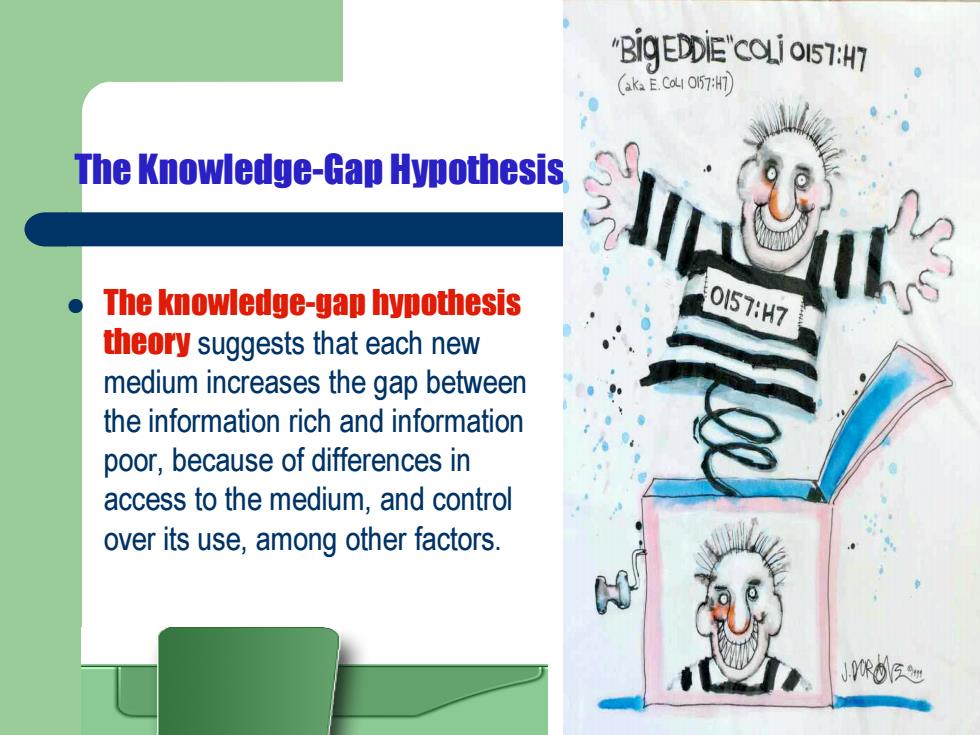
"BIQ EDDE'COLi 0I57:H7 aka E.CoL057:H The Knowledge-Gap Hypothesis The knowledge-gap hypothesis 0157:H7 theory suggests that each new medium increases the gap between the information rich and information poor,because of differences in access to the medium,and control over its use,among other factors. U你的如
The Knowledge-Gap Hypothesis The knowledge-gap hypothesis theory suggests that each new medium increases the gap between the information rich and information poor, because of differences in access to the medium, and control over its use, among other factors
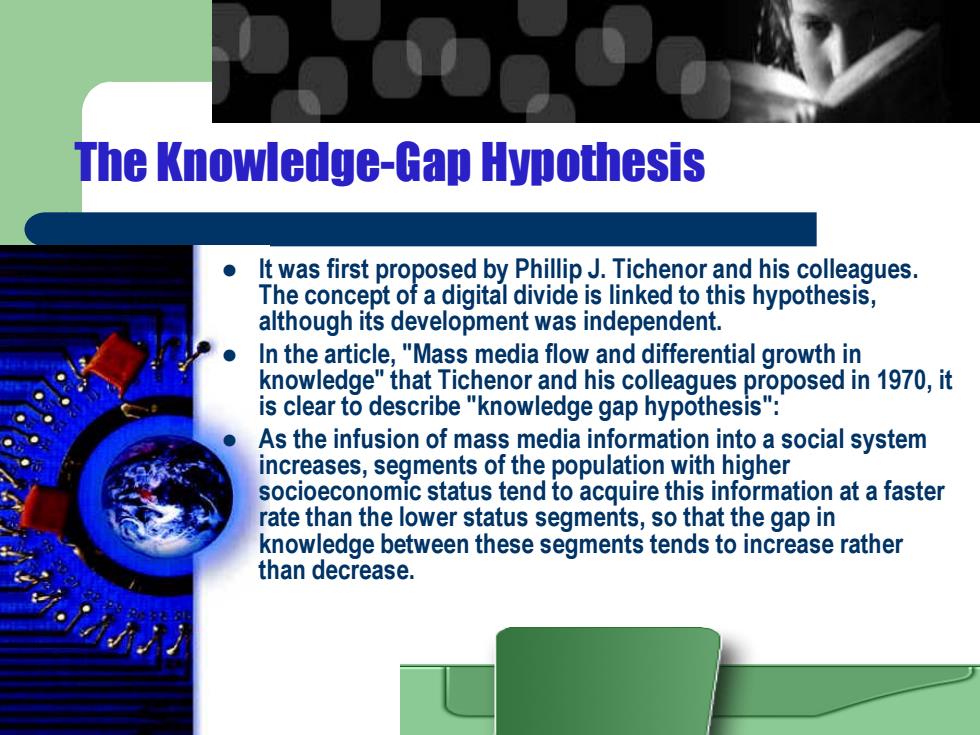
The Knowledge-Gap Hypothesis ● It was first proposed by Phillip J.Tichenor and his colleagues The concept of a digital divide is linked to this hypothesis, although its development was independent. ● In the article,"Mass media flow and differential growth in knowledge"that Tichenor and his colleagues proposed in 1970,it is clear to describe "knowledge gap hypothesis": As the infusion of mass media information into a social system increases,segments of the population with higher socioeconomic status tend to acquire this information at a faster rate than the lower status segments,so that the gap in knowledge between these segments tends to increase rather than decrease
The Knowledge-Gap Hypothesis It was first proposed by Phillip J. Tichenor and his colleagues. The concept of a digital divide is linked to this hypothesis, although its development was independent. In the article, "Mass media flow and differential growth in knowledge" that Tichenor and his colleagues proposed in 1970, it is clear to describe "knowledge gap hypothesis": As the infusion of mass media information into a social system increases, segments of the population with higher socioeconomic status tend to acquire this information at a faster rate than the lower status segments, so that the gap in knowledge between these segments tends to increase rather than decrease
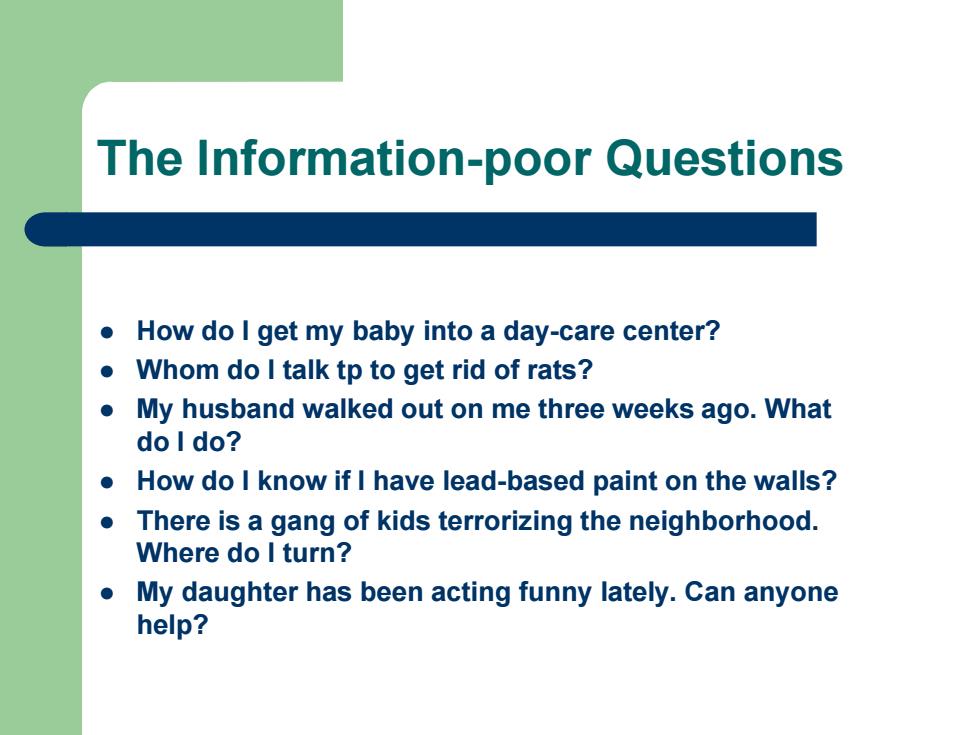
The Information-poor Questions How do I get my baby into a day-care center? Whom do I talk tp to get rid of rats? My husband walked out on me three weeks ago.What do I do? How do I know if I have lead-based paint on the walls? There is a gang of kids terrorizing the neighborhood. Where do I turn? ● My daughter has been acting funny lately.Can anyone help?
The Information-poor Questions How do I get my baby into a day-care center? Whom do I talk tp to get rid of rats? My husband walked out on me three weeks ago. What do I do? How do I know if I have lead-based paint on the walls? There is a gang of kids terrorizing the neighborhood. Where do I turn? My daughter has been acting funny lately. Can anyone help?
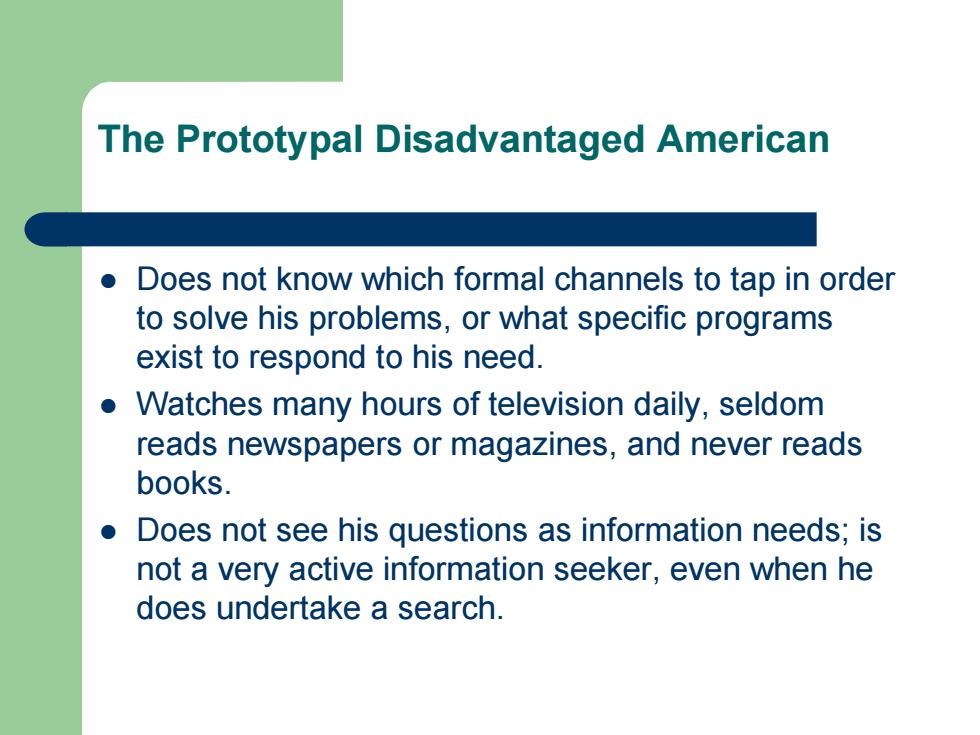
The Prototypal Disadvantaged American ● Does not know which formal channels to tap in order to solve his problems,or what specific programs exist to respond to his need. Watches many hours of television daily,seldom reads newspapers or magazines,and never reads books. Does not see his questions as information needs;is not a very active information seeker,even when he does undertake a search
The Prototypal Disadvantaged American Does not know which formal channels to tap in order to solve his problems, or what specific programs exist to respond to his need. Watches many hours of television daily, seldom reads newspapers or magazines, and never reads books. Does not see his questions as information needs; is not a very active information seeker, even when he does undertake a search
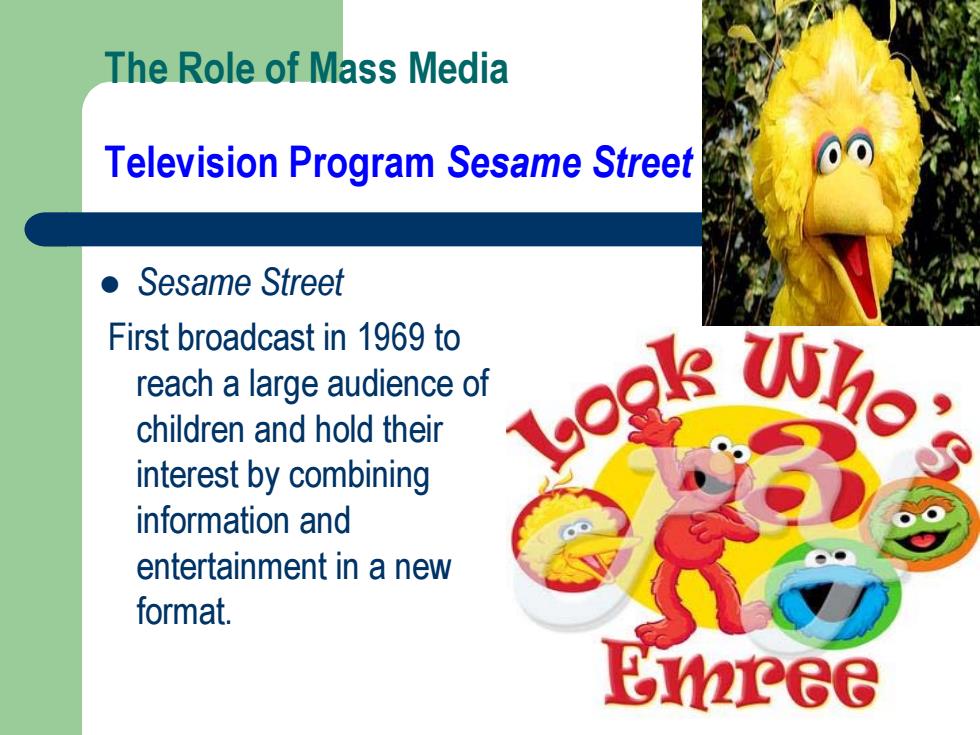
The Role of Mass Media Television Program Sesame Street Sesame Street First broadcast in 1969 to reach a large audience of children and hold their interest by combining information and entertainment in a new format. Emaree
The Role of Mass Media Television Program Sesame Street Sesame Street First broadcast in 1969 to reach a large audience of children and hold their interest by combining information and entertainment in a new format
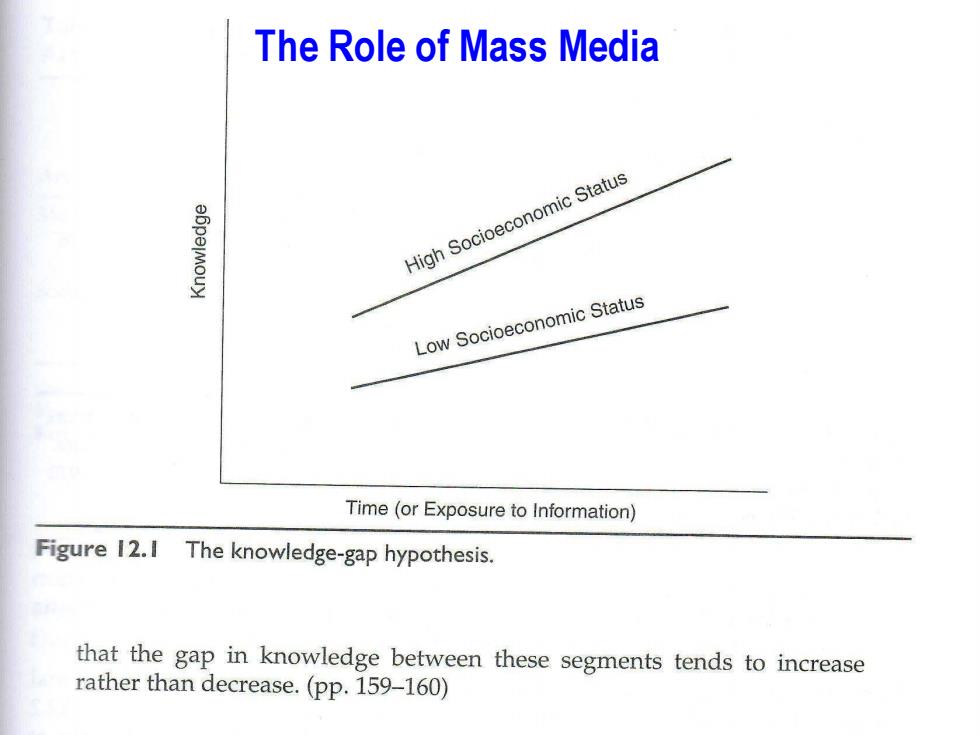
The Role of Mass Media High Socioeconomic Status Low Socioeconomic Status Time(or Exposure to Information) Figure 12.I The knowledge-gap hypothesis. that the gap in knowledge between these segments tends to increase rather than decrease.(pp.159-160)
The Role of Mass Media
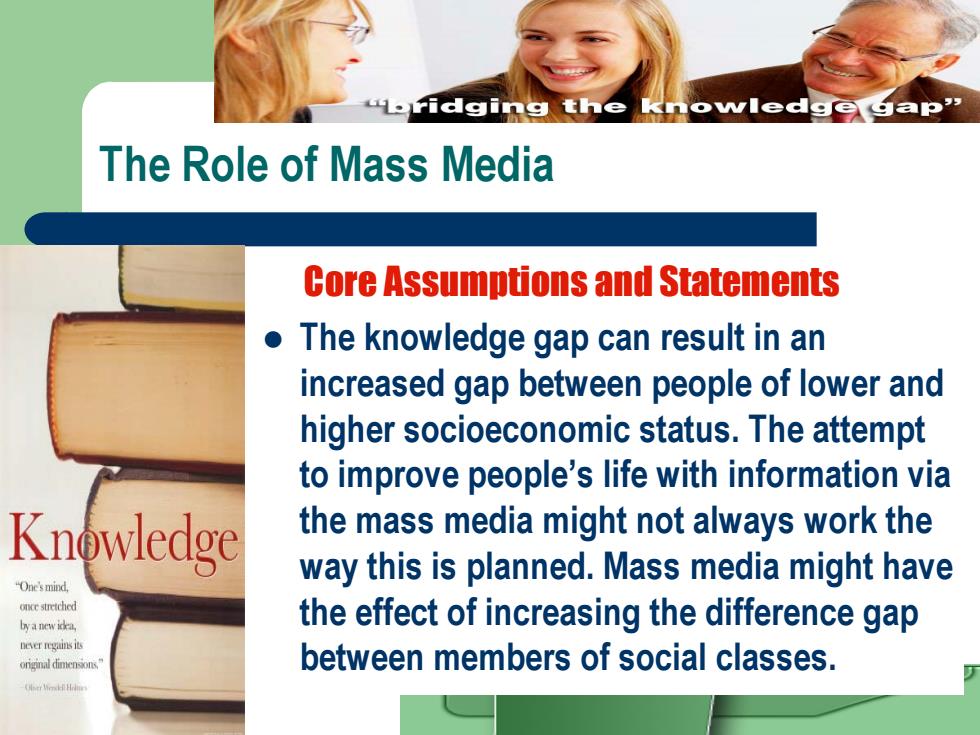
bridging the nowledge gap The Role of Mass Media Core Assumptions and Statements The knowledge gap can result in an increased gap between people of lower and higher socioeconomic status.The attempt to improve people's life with information via Knowledge the mass media might not always work the way this is planned.Mass media might have One's mind. sttched by a new idea. the effect of increasing the difference gap never regains its original dimensions between members of social classes. rmH
Core Assumptions and Statements The knowledge gap can result in an increased gap between people of lower and higher socioeconomic status. The attempt to improve people’s life with information via the mass media might not always work the way this is planned. Mass media might have the effect of increasing the difference gap between members of social classes. The Role of Mass Media
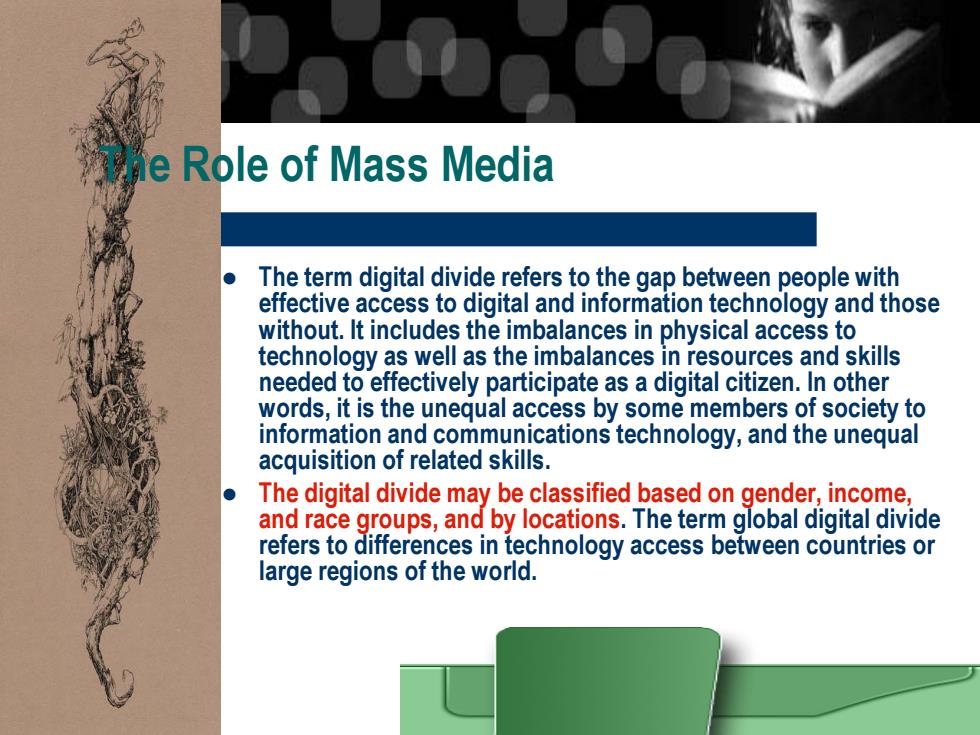
e Role of Mass Media The term digital divide refers to the gap between people with effective access to digital and information technology and those without.It includes the imbalances in physical access to technology as well as the imbalances in resources and skills needed to effectively participate as a digital citizen.In other words,it is the unequal access by some members of society to information and communications technology,and the unequal acquisition of related skills. The digital divide may be classified based on gender,income, and race groups,and by locations.The term global digital divide refers to differences in technology access between countries or large regions of the world
The term digital divide refers to the gap between people with effective access to digital and information technology and those without. It includes the imbalances in physical access to technology as well as the imbalances in resources and skills needed to effectively participate as a digital citizen. In other words, it is the unequal access by some members of society to information and communications technology, and the unequal acquisition of related skills. The digital divide may be classified based on gender, income, and race groups, and by locations. The term global digital divide refers to differences in technology access between countries or large regions of the world. The Role of Mass Media

80 College 70 60 High School 0 Grade School 20 10 1949 1954 1959 1965 Figure 12.2 Respondents in national surveys stating belief that man will reach the moon, by education and year.Source:From P.J.Tichenor,G.A.Donohue,and C.N.Olien,"Mass Media Flow and Differential Growth in Knowledge,"Public Opinion Quarterly 34(1970):166.Copyright 1970 by Columbia University Press.Reprinted by permission of the University of Chicago Press. 2.At a given time,there should be a higher correlation between acquisition of knowledge and education for topics highly publicized in the media than for topics less highly publicized